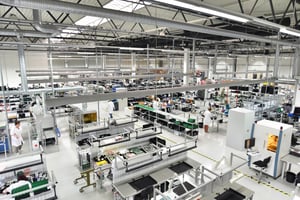
For most manufacturer’s, increasing revenue and profit is a priority. But growth brings with it new challenges, many of which have the potential for big changes that will impact the business for years to come. Manufacturing space may be one of those challenges.
Read here how one manufacturer was able to achieve $6K+ savings per hour invested in their study!
When it seems like your business is bursting at the seams, there are many questions to be asked and answered before a solution is reached. While the questions are slightly different for every organization, here are 7 considerations that all manufacturing businesses should take into account when evaluating whether to expand or relocate facilities:
1. What’s putting pressure on our current facilities?
Being aware of typical business ebbs and flows can save many headaches, as perhaps your facilities are only being strained based on a particularly strong sales season or one-off situation that doesn’t lead to more long-term gains that will need to be considered. Short-term stresses don’t necessarily require major overhauls – though they can help your business determine how much facilities can be stretched if and when more long-term issues arise.
2. Is there an easy, non-facilities related solution?
Additional automation may be a viable option. For example, adding a servo press to a stamping plant can have a big impact on PPH (production pieces per hour). Robotics may also be an option.
Another option may be to outsource some of the low value-added work to a contract manufacturer. If you have companies you know you can count on, that may be a good option - If not, it could be more trouble than it’s worth.
Based on the availability of qualified labor in your area, you could also consider adding a second shift.
3. Can your current space be updated?
Just because you don’t have enough room now doesn’t mean you have to undertake an expensive move. You might be able to solve your space needs simply by implementing a more efficient floor plan. If that isn’t enough, perhaps a remodel or even an expansion can get you the square footage needed. For example, constructing a mezzanine in your current space and moving some of the light assembly there could be just what you need.
4. Does your current location meet your other resourcing needs?
Space might not be the only concern when your business is growing. Proximity is important, too – to new employees, customers, suppliers, transportation, vendors, or distribution points. There are many factors to consider that could lead your organization to choose a new location even though a current facility remodel or expansion could solve your space issues.
5. What do your budget and timeline dictate?
Time is money, and your business has its limits with both. Relocation costs like purchasing the property, office and facility supplies and equipment, moving fees, and even loss of productivity during the move could make moving a non-starter. On the flip side, if you have a project that requires more space or better technology immediately, relocating into a facility that can meet these needs could be the only solution.
6. What additional financial aspects are there?
Existing in one location versus another brings myriad financial considerations, including taxes, utilities costs, shipping logistics, and more. Each of these factors needs to be considered as part of the decision between expanding on a current site and moving to a new one.
7. Should you rent or should you buy?
This question brings with it a host of additional considerations that are different for every business, but a few of the most common are:
- What role will technology play? If you’re considering renting an older facility, be sure to account for upgrades to power or communications you would require. It could prove to be too much to make the facility worthwhile.
- What are the tax implications? Renting or buying can come with varying financial benefits in the form of local, state, or federal tax credits.
- What modifications are needed? Permanent facility modifications may not be possible when renting, so that can limit your options based on existing facilities you might consider.
- How long will you stay? Your expected operation timeline in your new facility could dictate whether it’s better to rent or buy. That could mean anything from tax considerations (like depreciation) to negotiating strength (longer-term lease to lower rent cost).
As you can tell from all the considerations noted (plus the several additional considerations for your unique business), identifying the perfect new space for your business is no easy task. Hiring a consultant to take advantage of expert help could be a valuable investment.
It could also be valuable to keep the R&D Tax Credit in mind. After all, the research and development activities related to optimizing and innovating a workspace have the potential to qualify for this lucrative tax credit.
Read how one manufacturer was able to achieve $6K+ savings per hour invested in their study and use it to optimize floor space with new equipment.





